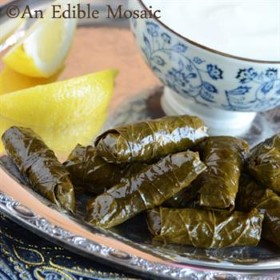Ingredients
Cooking Time: 1 hour, 45 minutes
1½ cups (325 g) uncooked medium-grain white rice, rinsed
3 tablespoons oil
1 onion, finely diced
2½ teaspoons salt, divided
2 tomatoes, finely diced
1 bunch fresh parsley, minced
6 tablespoons (90 ml) fresh lemon juice, divided
4 tablespoons olive oil, divided
4 tablespoons dried, crushed mint
One (1 lb/500 g) jar of brined grape leaves, rinsed
2 medium potatoes, peeled and sliced
Hot water, to cook the grape leaves
Plain yogurt (optional, for serving)
2 lemons, wedged (optional, for serving)
Directions
Grape leaves (or vine leaves) can be stuffed with either a vegetable or meat-based rice stuffing. This recipe is the vegetarian version, which is light and fresh, more like a salad than anything else. The version with meat is typically served hot as a main course; this vegetarian variation is usually served at room temperature, as part of a maza platter. (Note: When the stuffed grape leaves are cooked, a heavy, flat, disk-shaped object must be placed into the pot to weigh the leaves down and keep them submerged beneath the liquid. In Arabic, this tool is called a Teteelet Fakhar, but any heat-safe lid or plate that fits nicely into your pot will work.)
1. Soak the rice in tepid water for 10 minutes; drain.
2. Heat the oil in a large skillet over medium heat; add the onion and 1 teaspoon salt, and sauté until the onion starts to soften, about 3 to 5 minutes. Cool completely.
3. Combine the onion, 1¼ teaspoons salt, tomato, parsley, 3 tablespoons lemon juice, 2 tablespoons olive oil, mint, and rice in a large bowl; cover the bowl and refrigerate 3 hours.
4. Soak the grape leaves in hot water for 10 minutes, changing the water twice; drain. Trim off the stems, if necessary.
5. To stuff the grape leaves, lay 1 leaf flat on your work surface with the shiny side facing down. Place 2 to 3 teaspoons of filling (adjust the amount based on the size of your leaves) across the leaf above the point where the stem was cut off. Fold the bottom of the leaf up over the stuffing, and then fold over the sides of the leaf onto the stuffing. Roll up the leaf, tucking in the sides as you go. Continue this way until all the leaves are stuffed. (Note: If you have any leaves that are very small, you can place 2 leaves overlapping and stuff them.)
6. Line the bottom of a medium-large, thick-bottomed, lidded pot with the potato. Arrange the grape leaves (seam-side down) in compact rows on top of the potatoes, continuing with additional layers until all the grape leaves are in the pan.
7. Sprinkle the remaining 3 tablespoons of lemon juice, remaining 2 tablespoons of olive oil, and remaining ¼ teaspoon salt on top of the leaves; place a heavy, flat, disc-shaped object (such as a heat-safe lid or plate) into the pan on top of the leaves. Add enough hot water to cover the leaves by 2 inches (5 cm).
8. Bring to a boil over high heat, then cover the pot, turn the heat down to low, and simmer until the rice is tender, about 1 hour, 15 minutes to 1 hour, 45 minutes; cool.
9. To serve, drain the stuffed grape leaves in a large colander, reserving the liquid in a bowl under the colander (store any leftovers in this liquid). Arrange on a platter and serve at room temperature, along with plain yogurt and lemon if using.
